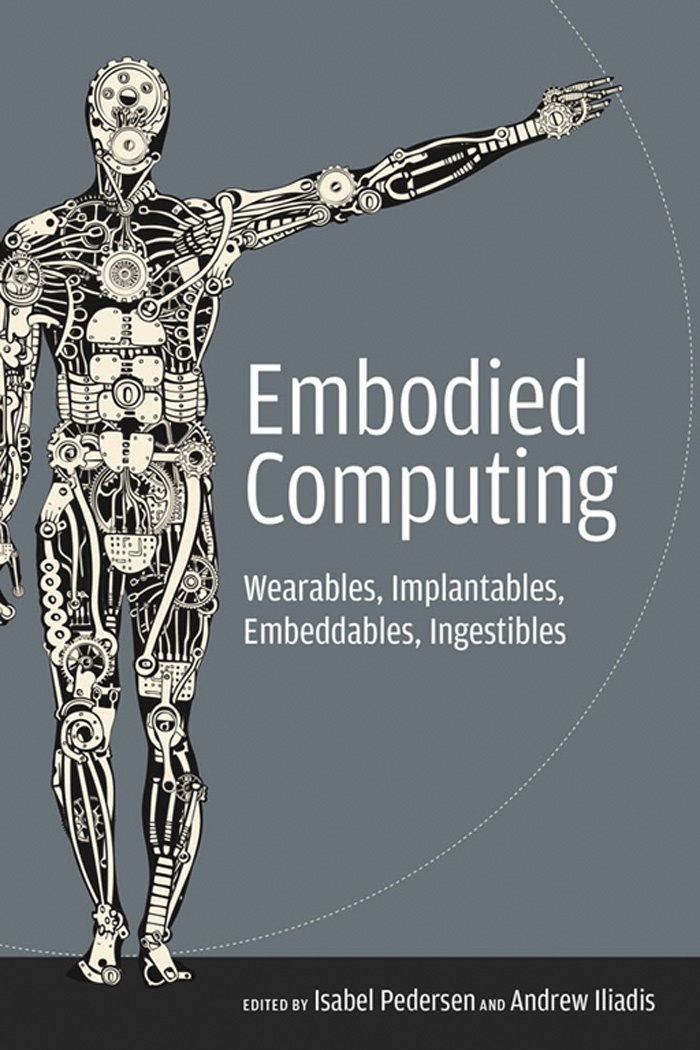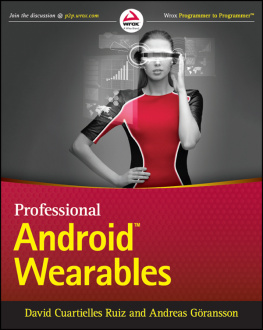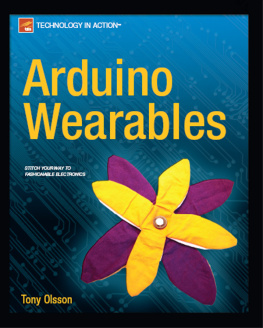Isabel Pedersen - Embodied Computing: Wearables, Implantables, Embeddables, Ingestibles
Here you can read online Isabel Pedersen - Embodied Computing: Wearables, Implantables, Embeddables, Ingestibles full text of the book (entire story) in english for free. Download pdf and epub, get meaning, cover and reviews about this ebook. year: 2020, publisher: The MIT Press, genre: Romance novel. Description of the work, (preface) as well as reviews are available. Best literature library LitArk.com created for fans of good reading and offers a wide selection of genres:
Romance novel
Science fiction
Adventure
Detective
Science
History
Home and family
Prose
Art
Politics
Computer
Non-fiction
Religion
Business
Children
Humor
Choose a favorite category and find really read worthwhile books. Enjoy immersion in the world of imagination, feel the emotions of the characters or learn something new for yourself, make an fascinating discovery.

- Book:Embodied Computing: Wearables, Implantables, Embeddables, Ingestibles
- Author:
- Publisher:The MIT Press
- Genre:
- Year:2020
- Rating:4 / 5
- Favourites:Add to favourites
- Your mark:
- 80
- 1
- 2
- 3
- 4
- 5
Embodied Computing: Wearables, Implantables, Embeddables, Ingestibles: summary, description and annotation
We offer to read an annotation, description, summary or preface (depends on what the author of the book "Embodied Computing: Wearables, Implantables, Embeddables, Ingestibles" wrote himself). If you haven't found the necessary information about the book — write in the comments, we will try to find it.
Isabel Pedersen: author's other books
Who wrote Embodied Computing: Wearables, Implantables, Embeddables, Ingestibles? Find out the surname, the name of the author of the book and a list of all author's works by series.
Embodied Computing: Wearables, Implantables, Embeddables, Ingestibles — read online for free the complete book (whole text) full work
Below is the text of the book, divided by pages. System saving the place of the last page read, allows you to conveniently read the book "Embodied Computing: Wearables, Implantables, Embeddables, Ingestibles" online for free, without having to search again every time where you left off. Put a bookmark, and you can go to the page where you finished reading at any time.
Font size:
Interval:
Bookmark:

edited by Isabel Pedersen and Andrew Iliadis
The MIT Press
Cambridge, Massachusetts
London, England
2020 Massachusetts Institute of Technology
All rights reserved. No part of this book may be reproduced in any form by any electronic or mechanical means (including photocopying, recording, or information storage and retrieval) without permission in writing from the publisher.
This book was set in ITC Stone Serif Std and ITC Stone Sans Std by Toppan Best-set Premedia Limited.
Library of Congress Cataloging-in-Publication Data
Names: Pedersen, Isabel, editor.
Title: Embodied computing : wearables, implantables, embeddables,
ingestibles / Isabel Pedersen and Andrew Iliadis, editors.
Description: Cambridge, Massachusetts : The MIT Press, [2020] | Includes
bibliographical references and index.
Identifiers: LCCN 2019025807 | ISBN 9780262538558 (paperback)
Subjects: LCSH: Wearable technology. | Wearable computers. | Artificial
intelligence. | Implants, Artificial.
Classification: LCC QA76.592 .E43 2020 | DDC 006.3--dc23
LC record available at https://lccn.loc.gov/2019025807
10 9 8 7 6 5 4 3 2 1
Isabel Pedersen and Andrew Iliadis
Andrew Iliadis
Isabel Pedersen
Deborah Lupton
Kevin Warwick
Katina Michael, M. G. Michael, Christine Perakslis, and Roba Abbas
Marcel OGorman
Gary Genosko
Suneel Jethani
Elizabeth Wissinger
Maggie Orth
Wed like to thank each of the chapter authors for Embodied Computing. They have made a significant contribution and showed unending patience as we finished the book. For that, we are grateful. Wed also like to thank the MIT Press and our editors, Doug Sery and Noah Springer, as well as Elizabeth Agresta, Susan Clark, Bridget Leahy, and the anonymous reviewers who provided rich insights into the collection and the work surrounding it. The book started as a symposium organized by the Decimal Lab at Ontario Tech University. Wed like to thank each of the presenters at that symposium, including Donald Braxton, Gary Genosko, Brian Greenspan, Stuart Murray, Marcel OGorman, and Tom Sherman. Nene Brode, Judy Ehrentraut, Kirsten Ellison, Steven Richardson, and Laura Tsang presented in the graduate student conference portion of the event. We thank Olexander Wlasenko and Whitby Station Gallery, who partnered with Decimal Lab to host an exhibit of artwork by Maggie Chan, Izzie Colpitts-Campbell, Kate Hartman, Erin Lewis, Izabella Pruska-Oldenhof, Jessica Thompson, Robert Tu, and Amelia Zhang. Wed also like to thank our schools and departments, Communication and Digital Media Studies in the Faculty of Social Science and Humanities at Ontario Tech University and the Department of Media Studies and Production in the Lew Klein College of Media and Communication at Temple University. Portions from our introduction draw from our article The Fabric of Digital Life: Uncovering Sociotechnical Tradeoffs in Embodied Computing through Metadata (June 3, 2018), Journal of Information, Communication and Ethics in Society 16, no. 3. On a personal note, wed like to thank some of our collaborators and mentors for their many conversations, including Dawn Armfield, Sharon Caldwell, Jayden Cooper, Marcel Danesi, Ann Hill Duin, Quinn DuPont, R. Bruce Elder, Jan Fernback, Ihor Junyk, Tracey P. Lauriault, Tony Liao, Matthew Lombard, Sorin Adam Matei, Ashley Rose Mehlenbacher, Tanner Mirrlees, Andrea Slane, Peter Stoett, Peter Turk, and Daniel W. Smith. This research was undertaken, in part, thanks to funding from the Canada Research Chairs program and the Social Sciences and Humanities Research Council of Canada.
Isabel Pedersen and Andrew Iliadis
In 1961, MIT mathematicians Claude Shannon and Edward Thorp engineered an unusual device that could be placed within a shoe to cheat at roulette. Thorp described the process in a 1998 paper, boldly titled The Invention of the First Wearable Computer. The goal was to track the roulette ball over periods of time, from the croupiers launch through the stuttering of the moving rotor to the eventual resting pocket location. Thorp and Shannon considered a variety of designs before eventually settling on a computer that had twelve transistors and was the size of a pack of cigarettes. The wearable worked by inputting data with the operators big toe via microswitchesbut the project was not an enduring success (much to the chagrin of would-be cheaters). Authorities eventually discovered the invention and on May 30, 1985, a law was passed in Nevada that prohibited the use of wearables in casinos. While the roulette shoe might be the first recorded instance of a wearable (computational) technology, it is also one of the first cases where a wearable precipitated change in law and policy.
Fast forward to now, and the production of consumer wearable technologies proliferates at an astounding rate. Fitness monitoring devices (Fitbit, for example) are regularly used by many health-conscious people and in some cases even by their pets (the company PetPace has released a collar for monitoring pet health), while the Augmented World Expo and communities like it have expanded interest in body-centered computing around the globe. Currently, there are thousands of wearables available on the market or in development. The Annual CES show in Las Vegas (formerly the Computer Electronics Show) boasts 170,000 attendees and helps circulate wearable tech news about prerelease innovations on social media. Vandrico Inc.s Wearable Technology Database contained over 430 devices from 250 companies. Companies such as Google, Snapchat, Huawei, North, and Vuzix have developed smart glasses, and athletes are increasingly training with the aid of smart clothing that records biometrics to help improve performance, an example of what Nafus (2016) describes as biosensing technologies.
Artificial intelligence (AI), now a global industry, has changed computing paradigms in every sector, including those developing the technologies that are worn on and in peoples bodies. The drive in these sectors is to make embodied computers intelligent, autonomous, and capable of making decisions, but the sectors also spur popular social movements about the future. Personal computing devices are accruing a much greater range of public expectations than before. Consequently, more immersive embodied technologies are announced, circulated in popular forums, and have started phases of commodification. DARPA has developed brain interface technologies for braincomputer interaction, Google is proposing bionic contact lenses, and epidermal tattoos (skin technologies) are already a consumer product. It is becoming quite clear that the word wearables is something of a misnomer because it is used to describe so much more than the act of wearing technology. At the same time, wearables usually refers to things like fitness-monitoring devices or wearable cameras. Most people dont tend to think of involuntary tracking technologies as wearablesprisoners ankle monitoring bracelets or employees wearing tracking devices. Embeddable technologies are not wearable technologies, exactly. Wearables doesnt accurately describe things like implants and bionic technology, but that is often the intention. Wearables and embodied computing technologies have also often been tied to utopian dreams of technology-enabled solutions for everything from sickness to security threats, but rarely are such technologies situated within social and cultural frameworks in industry.
Next pageFont size:
Interval:
Bookmark:
Similar books «Embodied Computing: Wearables, Implantables, Embeddables, Ingestibles»
Look at similar books to Embodied Computing: Wearables, Implantables, Embeddables, Ingestibles. We have selected literature similar in name and meaning in the hope of providing readers with more options to find new, interesting, not yet read works.
Discussion, reviews of the book Embodied Computing: Wearables, Implantables, Embeddables, Ingestibles and just readers' own opinions. Leave your comments, write what you think about the work, its meaning or the main characters. Specify what exactly you liked and what you didn't like, and why you think so.









